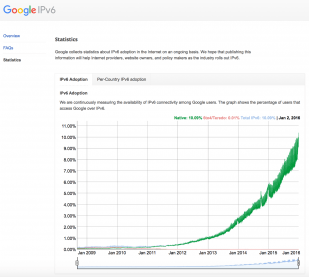Every Monday morning, as a matter of ritual it seems, I check the Google IPv6 adoption graph to see the latest numbers. Today, I was thrilled to see it finally top 10%! That means that 10% (10.41% on January 1, to be precise) of the traffic hitting Google’s servers – a pretty good indicator of overall Internet traffic – is coming from an IPv6 connection.

We consider hitting the 10% mark a major milestone. It was just over a year ago that the number crossed 5%, which we reported at the time. It’s taken a little longer than a year to double from that number but still it has doubled in close to a year and that’s a pretty good growth rate. I’m very happy to see that.
We made an ambitious prediction in early 2014 that we would see the 10% mark by the end of 2014. We knew at the time that was an ambitious prediction and it turned out to be wildly ambitious. We were coming off a year of impressive growth in 2013 and it was conceivable that we would see something close to that number. Growth slowed in 2014, but seems to have settled into a steady upward trajectory. For those of you who are statistically inclined, Eric Vyncke has a great tool that allows you to make some predictions about IPv6 growth.
IPv6 deployment is important for the future of the Internet. IPv6 is the protocol that gives us truly global addressing for every device that attaches to the Internet. In addition to all the screens that we use in all aspects of our lives every day now, we anticipate an explosion of other smart devices attaching to the Internet in the coming years. The Internet Society’s recent paper on the Internet of Things just begins to scratch the surface on the IP addressing needs, but it’s an area we expect to have a big impact on IPv6 deployment.
Much remains to be done to see pervasive IPv6 in the Internet. We’ve seen significant broadband deployments across the world, and more recently we are encouraged to see uptake of IPv6 in mobile networks. Verizon Wireless deployed IPv6 early and both they and T-Mobile USA have large IPv6 deployments. It is encouraging to note that the four major US mobile operators now all have measurable IPv6 deployments. In addition, SK Telecom, the largest mobile operator in South Korea, also has a large deployment of IPv6. So IPv6 deployment in mobile networks is also taking hold now.
When Google reports that IPv6 adoption is at 10% from their perspective, it’s another opportunity for operators of network infrastructure connected to the Internet to take note.
My Google IPv6 graph habit is no doubt nerdy, but I’ve been working on IPv6 in one way or another for more than 15 years. It’s great to see it deployed and growing consistently, year-over-year, and to be able to report on that trend over a period of a few years. I look forward to seeing that number continue to increase!
We think 2016 is off to a great start so far. So, what are your plans for IPv6 deployment in your network in 2016? Let us know!

